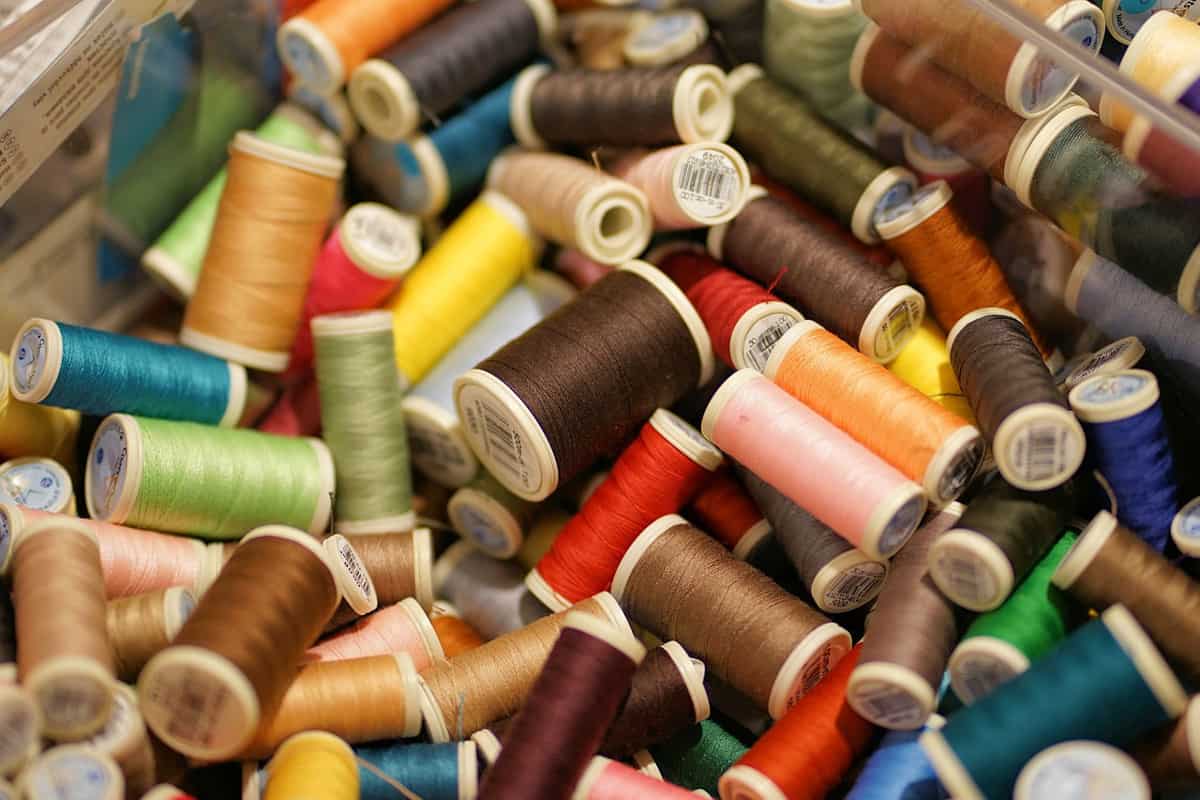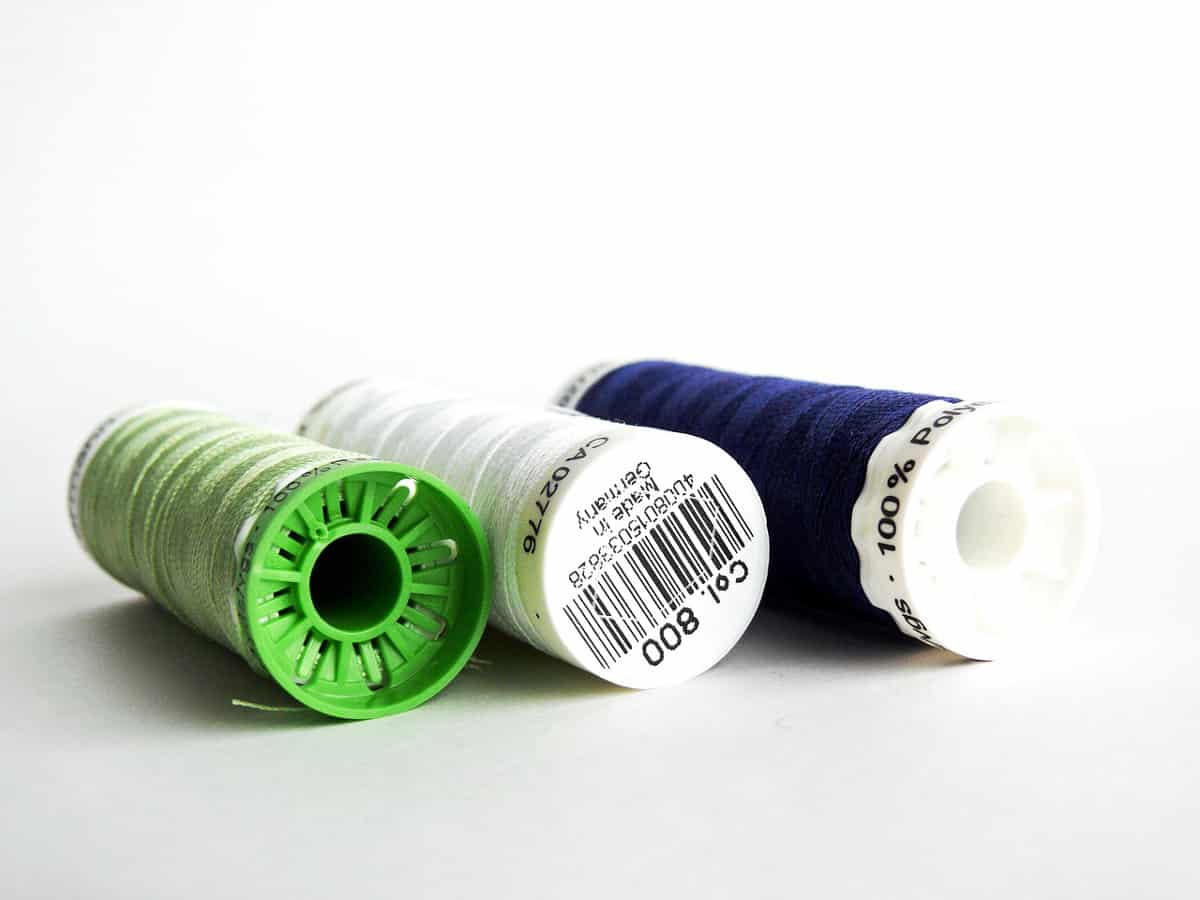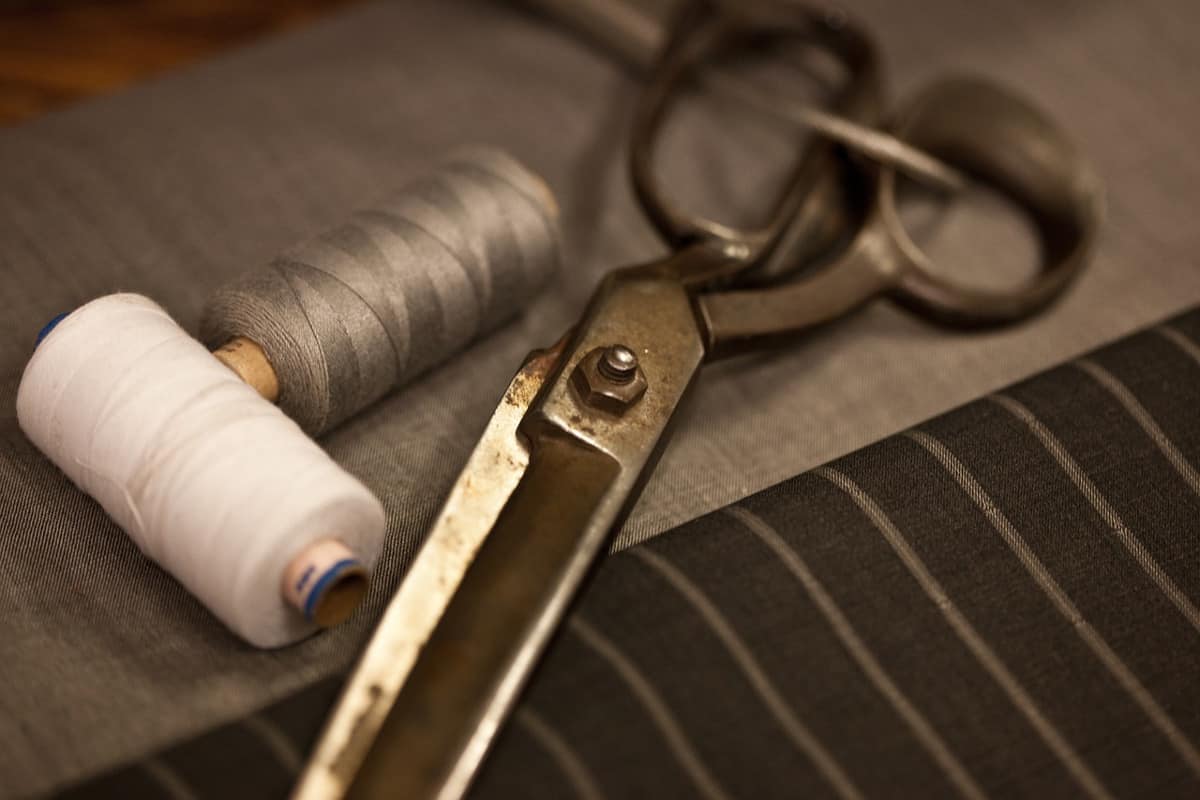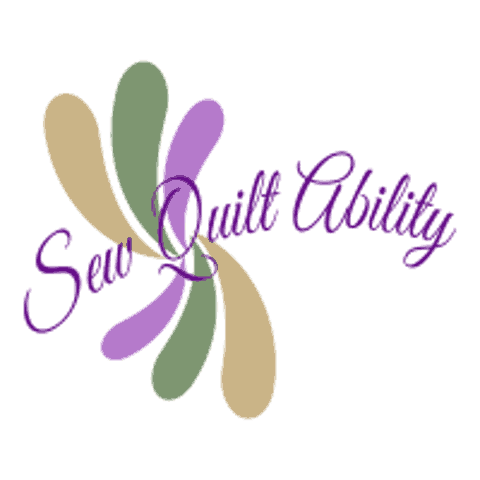For every phase of quiltmaking, quilters use thread whether piecing by hand or machine, doing appliqué, embellishing and the actual quilting itself.
With a huge and sometimes overwhelming variety, quiltmakers have a lot of threads to choose from.
You might be wondering, what is the best thread to use for quiltmaking?
Well, it largely depends on the fabrics you are using for your quilts.
It takes thread of different fibers, weight and color to achieve the finished project you are after.
Each step of the quilting process (piecing, embellishing, machine or hand quilting) will have better results if you use the thread made for that purpose.
Thread is what holds patchwork pieces together, anchors batting to the fabric.
Thread can also highlight and enhance the quilted project with color and texture.
From my many years of sewing and quilting, I go into detail what is the best thread to use for the different aspects of quiltmaking.
Thread Facts
Thread is made by twisting strands of fiber that are spun from cotton, wool, silk or synthetic material.
Typically, the more tightly twisted the thread is, the thinner the diameter of the thread will be.
The diameter (thickness) of the thread is called denier.
Thread is numbered according to the thickness of the thread.
The lower the number is, the thicker will be the thread.
Some thread is plied, meaning several strands are twisted together which forms a single thickness.
By plying two or more strands together, it increases a thread’s strength; whereas, the thread will be smoother when fewer strands are twisted together.
There are some threads that are manufactured by wrapping one thread around a filler core of a different fiber content.
Normally the filler core is of a stronger fiber, then the thread wrapping around it, which increases the strength of a thread.
An example of this are special-effect metallic threads with the prettier but weaker thread on the outside wrapped around a stronger filler core.
Threads that can be used for quilting are available in natural fibers.
Such as cotton and silk and also numerous synthetic fibers like metallic, polyester and nylon (monofilament).
What Type Of Thread Is Strongest

It will help you evaluate the strength and also the physical characteristics of a particular thread by knowing the fiber content.
Man-made fibers are usually stronger than natural ones.
Thus, polyester or nylon thread will be less likely to break or fray than will cotton thread.
When maximum strength is required for stitching through heavy and bulky materials, a synthetic thread is ideal.
When choosing thread, it should be compatible in strength to the technique that you will be using when quiltmaking.
For instance, when hand quilting, you need a thread that can hold up to repeated needling through the layers of the quilt sandwich without it fraying or breaking.
If you are machine quilting, you need to determine which combination of thread and needle will be the most successful for the desired outcome of your quilted project.
To determine the desired effect you are after, compare the color, texture and sheen of different types of threads.
Cotton threads will give a lovely matte luster while silk will produce a luxurious highly polished sheen.
Metallic thread will give you a sparkling and shiny look for hand or machine quilting.
Weigh the strength of a thread over its visual attributes.
Threads of natural fibers have characteristics that can make them preferred over synthetic ones even though they might not be as strong.
An example of this would be 100 percent cotton Madeira Cotona thread (link to read reviews on Amazon).
Although not especially strong, it’s ideal for machine stippling and other fine quilting.
This 80 weight thread virtually melts into the background because of its hair-like fineness, enhancing the “shadows and valleys” of stipple quilting.
Thread Types

With thread having multiple roles for quilting from holding everything together to piecing the different quilt blocks and adding color and texture to the quilt surface, its important to choose the right thread for your project.
When talking about thread types, two questions come to mind.
“Is it better to sew with cotton or polyester thread?”
“Which thread is better, cotton or polyester?”
Back in the olden days, cotton thread was all that was available.
Thus the reason you might hear some say you should only use cotton thread when using cotton fabrics to make your quilts.
But today we have many other types of thread to choose from depending on what we would like to achieve for our quilted project.
For some quilters that use cotton fabrics, 100% cotton thread is the best thread of choice.
Cotton thread is equal in strength to cotton fabric and will generally wear evenly, but not guaranteed to always do so.
Ideally, using quality fabric and thread should reduce any worries about wearing and shrinkage of the two together.
Synthetic threads like polyester or nylon are quite strong so they will last longer.
There are some who say that polyester thread can wear cotton fibers at the seam and tear the quilt but it’s not true.
Strong polyester thread might, under extreme usage, but so will a strong glazed cotton thread.
Softer non-glazed thread won’t tear through fabric under normal use.
As long as you use good quality thread, it’s perfectly fine to use any type.
There is one exception to this and that is nylon.
Over time, nylon (monofilament) thread can get brittle and might even discolor.
Other threads may be more appropriate than cotton for decorative quilting or embellishing.
By being sure to choose threads based on quality that is suitable for the task, it will give you a more pleasant experience and the outcome that you desire.
For my quilts I generally prefer threads that are subdued and aesthetically pleasing.
I like having the quilting design to show and not so much the threads.
Using subtle thread colors for machine quilting, the thread colors will blend with the fabrics and hide many stitching errors.
This is a good choice for beginners to use.
To maintain good tension throughout the quilt top while piecing, its best to have the same weight of thread in both the top (needle) and bottom (bobbin) while you are sewing.
This is also true when machine quilting and usually a good idea to use matching thread in both needle and bobbin as well.
Cotton Thread
Cotton thread seems to be a staple in quilting, the thread of choice for many quilters.
This thread has many advantages.
Working well with cotton fabric, this thread is strong enough to create quilt projects that are durable.
Cotton thread knots easily when you need to knot it and is available in many grades.
As a good quality thread, it has earned its reputation for being the thread of choice for many quilters.
Cotton thread is pretty easy to find and inexpensive which makes it suited for piecing, machine quilting and hand quilting.
For quiltmaking, use only a high quality cotton thread if using this type of thread.
To compare the quality of cotton thread, pull out a strand of thread, holding it up to the light.
A premium grade thread will be smooth or smoother while an inferior thread will have “fuzzies” or lint that protrudes from the sides of the strand of thread.
Mettler makes a silk finished cotton thread (link to read reviews on Amazon) that is a good quality thread for quilting.
It’s a go-to thread for many quilters who also say it doesn’t break easily or clog up their machines with too much lint like some cotton threads do.
Polyester Thread
Can you use polyester thread for quilting?
Yes, you can use polyester thread for quilting as well as for most sewing projects.
Polyester thread is considered a truly all purpose thread, a good choice for both machine and hand sewing projects.
Polyester thread has a little stretch to it which keeps it from breaking so easily like cotton thread does.
It especially works great for knits. It slides through fabric easily as it sometimes is coated with silicone or wax that also gives it some shine.

Gutermann 100% polyester thread (link to read reviews on Amazon) is the one that I use for nearly all my sewing and quilting projects.
I love using this thread, always making sure to keep many spools of it on hand.
Can you use polyester thread on cotton fabric?
Yes, a good quality polyester thread is perfectly fine to be used on cotton fabric and is a good choice of thread.
You might want to try a poly-wrapped poly core thread made by Superior Threads (link to read reviews on Amazon).
It’s a cleaner, brighter and stronger thread than some of the other poly-wrapped poly core and spun polyester threads.
Another good choice would be cotton-wrapped polyester thread.
Cotton-wrapped polyester thread has a polyester core with cotton wrapped around the polyester core.
This creates a stronger thread with a finish that’s characteristic of cotton thread.
Rayon Thread
What about rayon thread, can you use it for quilting?
Rayon thread is often referred to as “machine embroidery thread” and it can be used for nearly any type of machine application.
I have read in a few quilting books that, being a strong thread, you can use it for quilting.
But, I’ve also read its not recommended for quilting purposes because its a rather weak thread and not usually colorfast.
I have not used it for quilting but have many times for machine embroidery with wonderful success.
Rayon is a thread that has a silky lustrous appearance, is relatively inexpensive and comes in lots of brilliant colors which makes it a wonderful thread for machine embroidery.
If you decide to use it for embroidery embellishments on quilts or quilting projects, try to find good quality threads that have a high (4-5) colorfast rating.
Monofilament (Invisible) Thread
Can I use invisible thread for quilting?
Yes, generally used for machine quilting, when you don’t want the quilting thread to show, monofilament (invisible) thread can be used.
Monofilament thread is very popular among machine quilters because it is very easy to use and is widely available.
Monofilament thread gives a nearly invisible stitch, while leaving a nice crisp indentation for the quilting line.
This makes it especially appealing to beginning quilters whose stitches are not as perfect as the seasoned quilter.
Monofilament thread comes in two colors; clear for the lighter to medium fabrics and smoke for the darker fabrics.
It is also available in both nylon and polyester.
I have sewn with both the nylon monofilament and polyester monofilament threads and I much prefer the polyester one.
Superior Threads makes a Mono-Poly Invisible clear thread (link to read reviews on Amazon).
And Mono-Poly Invisible smoke thread (link to read reviews on Amazon).
This thread by Superior is the one that I use and love.
It remains soft and pliable, doesn’t turn yellow or get brittle with time like the nylon one does.
In the bobbin you should use a lightweight cotton thread or bobbin-fill in a color that matches your backing fabric.
Metallic Thread
Many quiltmakers are tantalized by the shimmering metallic threads that reflect light, adding movement and sparkle to their quilts surface.
The sheen and variety of colors that are available make these threads so appealing for decorative stitching.
Metallic threads however, do tend to fray and break more than cotton thread.
Using some precautions and the right equipment will make the sewing process smoother and successful.
Always use a metallic or large-eye needle specifically manufactured for metallic threads.
Schmetz Metallic needles (link to read reviews on Amazon) with their elongated eye, extra sharp points and a groove in the front of the needle help to reduce the friction against metallic threads.
Also sewing at a slower speed will help to reduce the stress and friction on the metallic thread.
Using a lightweight polyester or 50 weight cotton thread in the bobbin makes a more perfect balance with the weaker metallic thread.
Liquid silicone drops (depending on the sewing machine manufacturer’s specifications) may be added to the spool to make the thread run through the sewing machine easier.
Sullivans makes a fabulous silicone spray (link to read reviews on Amazon) works for all kinds of thread to eliminate skipped stitches.
And helps to prevent thread breakage among other things like allowing fabrics to slide easier when free-motion quilting.
Silk Thread
Unlike the short, spun fibers of cotton, silk thread, being a natural fiber, is very strong, stronger than cotton because it is a continuous filament.
Silk also has more stretch than cotton thread and will withstand brutal treatment.
In fact, you can mold silk thread into shape with the heat of your iron but the natural fibers won’t be damaged by excessive ironing.
Machine quilting puts more stress on thread so silk is useful for this application of the quilting process.
Silk is the most lustrous thread available, enhancing any quilting design with its sheen and highly polished luster.
Silk thread absorbs dye beautifully for the most brilliant colors you can imagine and comes in many sizes and weights.
Silk thread is preferred by many quilters for hand appliqué because it glides through the fabric easier than cotton and is usually a finer thread.
This makes it easier to hide the stitches for appliqué.
Longer lengths of silk thread can be used as it is less prone to fraying.
If you need a silk thread, YLI has been selling silk thread longer than anyone.
Their silk threads are the choice of some of the most accomplished designers throughout the world and recommended by many.
YLI silk threads are 100% pure filament silk (link to read reviews on Amazon) the very highest quality silk thread in the world.
Thread Weight
What does 40 weight thread mean?
Threads come in various weights (thicknesses) with the system of measurement being a little bit backwards of what we would normally think it should be.
The heavier the weight of the thread, the lower will be the number of that thread.
So, a 40 weight thread will actually be heavier than a lower weight thread of say 50 or 80 weight.
The 40 weight thread in this example will also be more visible and noticeable in your sewing or quilting project.
A thread weight of 80 will almost “melt” into your sewing item becoming less prominent.
Best Threads For Piecing, Hand Or Machine Quilting
What is the best thread for piecing your quilts?
Most quilters use 100% cotton fabrics.
When using these types of fabrics in your quilts or quilting projects, using 100% cotton or cotton-wrapped polyester thread of high quality will be a good choice to use.
When you are piecing with high contract fabrics, you will want to use two different colors of thread, one in the needle and one in the bobbin.
An example would be if one of your fabrics is an ivory or white color and the other is a dark fabric such as Burgundy.
Match the threads to the fabric colors (one ivory/white and one burgundy) using the same type and weight of thread.

Use thread in a neutral color such as gray, beige or taupe throughout the assembly of your quilt blocks if the quilt has fabrics that contain many colors.
What is the best thread for machine (free-motion) quilting?
Thread for machine quilting is used both for decoration and functionality.
The thread that might be best for one quilting project might not be the best for another.
There’s really no right or wrong thread when machine quilting as long as you are using a top quality thread.
Deciding what your desired outcome for the quilting is what will determine the thread you choose.
A 40 weight cotton, polyester-wrapped cotton or polyester thread are good choices for machine quilting on a home sewing machine.
The quilting stitches will show up more easily on the quilt if you use the 40 weight thread versus the finer 50 weight thread that’s better for piecing than quilting.
The thread that I use and absolutely love for quilting my quilts is a polyester thread that is smooth with an even twist, has no slubs and no lint build-up.
This So Fine #50/3 lint free, extra smooth all purpose polyester thread is made by Superior Threads (link to read reviews on Amazon).
What is the best thread for piecing quilt tops?
Considered a medium-weight thread, thread that is marked 50/3 (50 weight and 3 ply) works well for both hand and machine piecing.
An excellent choice would be a smooth and fine, strong, durable Aurifil Mako 50 weight 100% cotton thread (link to read reviews on Amazon).
Another good choice for piecing would be Mettler Silk-Finish Solid Cotton Thread (link to read reviews on Amazon).
The mercerization of all Mettler cottons creates that beautiful silk-like sheen, high breaking resistance and color fastness.
What color of thread should be used for machine quilting?
Generally, the color of thread to use is one that either complements, blends in with your fabrics or will add interest and enhancement to your quilt.
Its really all up to your choice of colors and what your desired outcome of the quilting should look like.
Auditioning threads by laying different thread color choices on the quilt top can help to decide which will look the best.
Making small sample quilt sandwiches and quilting them with the different color choices will also help in your final choice of thread color.
Some quilts might do well with variegated quilting thread.
Variegated quilting thread is where the color changes throughout the strand of thread.
Amount Of Thread For Quilting
“How much thread do i need for a quilt” can be somewhat of a loaded question.
How much thread you need to make a quilt will vary depending on the size of the quilt you are making.
It can also depend on whether you are counting the thread used to piece your quilt top only or if you will also be the one to hand or machine quilt it.
And then there’s the thread that will be used for adding the binding onto the quilt.
If the quilt design you have chosen to make contains appliqué, that is more thread you will need that is to be considered also.
Always use top quality thread to give you the best results for your quilting projects.
While it’s tempting to purchase cheap thread because of the large quantities needed for patchwork and quilting, you will find your quilting experience to be less than desirable.
Substandard threads can break and fray more than the top quality threads.
This will add unnecessary frustration to an otherwise enjoyable and pleasant quilting achievement.
Choose your threads by their quality, touch and performance and you will be a happy quiltmaker.

